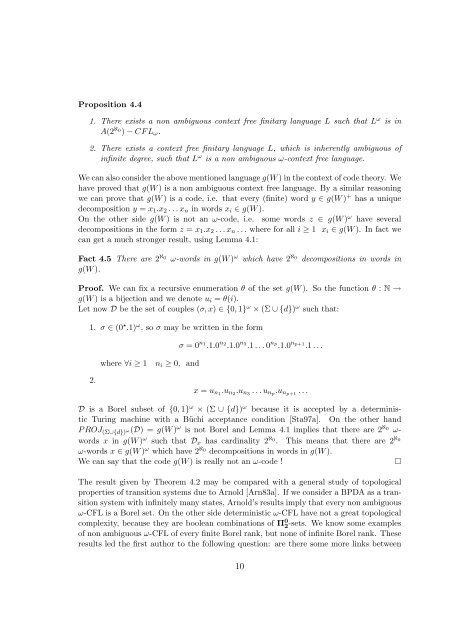Topology and ambiguity in ω-context free languages - HAL
Topology and ambiguity in ω-context free languages - HAL
Topology and ambiguity in ω-context free languages - HAL
Create successful ePaper yourself
Turn your PDF publications into a flip-book with our unique Google optimized e-Paper software.
Proposition 4.4<br />
1. There exists a non ambiguous <strong>context</strong> <strong>free</strong> f<strong>in</strong>itary language L such that L <strong>ω</strong> is <strong>in</strong><br />
A(2 ℵ 0<br />
) − CFL <strong>ω</strong> .<br />
2. There exists a <strong>context</strong> <strong>free</strong> f<strong>in</strong>itary language L, which is <strong>in</strong>herently ambiguous of<br />
<strong>in</strong>f<strong>in</strong>ite degree, such that L <strong>ω</strong> is a non ambiguous <strong>ω</strong>-<strong>context</strong> <strong>free</strong> language.<br />
We can also consider the above mentioned language g(W) <strong>in</strong> the <strong>context</strong> of code theory. We<br />
have proved that g(W) is a non ambiguous <strong>context</strong> <strong>free</strong> language. By a similar reason<strong>in</strong>g<br />
we can prove that g(W) is a code, i.e. that every (f<strong>in</strong>ite) word y ∈ g(W) + has a unique<br />
decomposition y = x 1 .x 2 ...x n <strong>in</strong> words x i ∈ g(W).<br />
On the other side g(W) is not an <strong>ω</strong>-code, i.e. some words z ∈ g(W) <strong>ω</strong> have several<br />
decompositions <strong>in</strong> the form z = x 1 .x 2 ...x n ... where for all i ≥ 1 x i ∈ g(W). In fact we<br />
can get a much stronger result, us<strong>in</strong>g Lemma 4.1:<br />
Fact 4.5 There are 2 ℵ 0<br />
<strong>ω</strong>-words <strong>in</strong> g(W) <strong>ω</strong> which have 2 ℵ 0<br />
decompositions <strong>in</strong> words <strong>in</strong><br />
g(W).<br />
Proof. We can fix a recursive enumeration θ of the set g(W). So the function θ : N →<br />
g(W) is a bijection <strong>and</strong> we denote u i = θ(i).<br />
Let now D be the set of couples (σ,x) ∈ {0, 1} <strong>ω</strong> × (Σ ∪ {d}) <strong>ω</strong> such that:<br />
1. σ ∈ (0 ⋆ .1) <strong>ω</strong> , so σ may be written <strong>in</strong> the form<br />
σ = 0 n 1<br />
.1.0 n 2<br />
.1.0 n 3<br />
.1...0 np .1.0 n p+1<br />
.1...<br />
where ∀i ≥ 1<br />
n i ≥ 0, <strong>and</strong><br />
2.<br />
x = u n1 .u n2 .u n3 ...u np .u np+1 ...<br />
D is a Borel subset of {0, 1} <strong>ω</strong> × (Σ ∪ {d}) <strong>ω</strong> because it is accepted by a determ<strong>in</strong>istic<br />
Tur<strong>in</strong>g mach<strong>in</strong>e with a Büchi acceptance condition [Sta97a]. On the other h<strong>and</strong><br />
PROJ (Σ∪{d}) <strong>ω</strong>(D) = g(W) <strong>ω</strong> is not Borel <strong>and</strong> Lemma 4.1 implies that there are 2 ℵ 0<br />
<strong>ω</strong>-<br />
words x <strong>in</strong> g(W) <strong>ω</strong> such that D x has card<strong>in</strong>ality 2 ℵ 0<br />
. This means that there are 2 ℵ 0<br />
<strong>ω</strong>-words x ∈ g(W) <strong>ω</strong> which have 2 ℵ 0<br />
decompositions <strong>in</strong> words <strong>in</strong> g(W).<br />
We can say that the code g(W) is really not an <strong>ω</strong>-code !<br />
□<br />
The result given by Theorem 4.2 may be compared with a general study of topological<br />
properties of transition systems due to Arnold [Arn83a]. If we consider a BPDA as a transition<br />
system with <strong>in</strong>f<strong>in</strong>itely many states, Arnold’s results imply that every non ambiguous<br />
<strong>ω</strong>-CFL is a Borel set. On the other side determ<strong>in</strong>istic <strong>ω</strong>-CFL have not a great topological<br />
complexity, because they are boolean comb<strong>in</strong>ations of Π 0 2-sets. We know some examples<br />
of non ambiguous <strong>ω</strong>-CFL of every f<strong>in</strong>ite Borel rank, but none of <strong>in</strong>f<strong>in</strong>ite Borel rank. These<br />
results led the first author to the follow<strong>in</strong>g question: are there some more l<strong>in</strong>ks between<br />
10
















